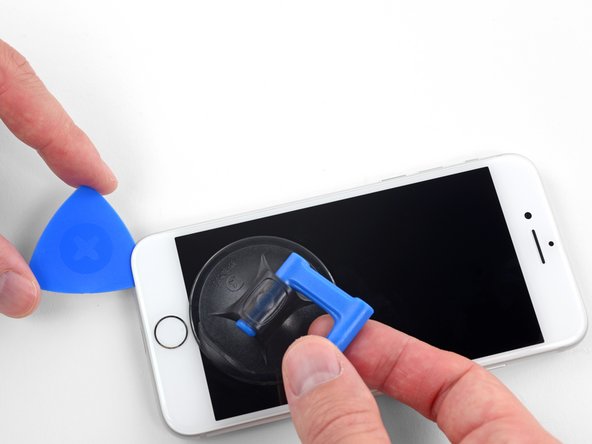Esta versão pode conter edições incorretas. Mude para o último instantâneo verificado.
O que você precisa
-
Este passo não foi traduzido. Ajude a traduzi-lo
-
Power off your iPhone before beginning disassembly.
-
Remove the two 3.4 mm pentalobe screws on the bottom edge of the iPhone.
-
-
-
Meça 3 mm a partir da ponta e marque a palheta com um marcador permanente.
-
-
-
Puxe a pega azul para trás para destravar os braços do Anti-Clamp.
-
Deslize os braços pela borda esquerda ou direita do seu iPhone.
-
Posicione as ventosas próximo à borda inferior do iPhone, diretamente acima do botão home - uma pela dianteira e a outra pela traseira.
-
Aperte as ventosas uma contra a outra para aplicar sucção na área desejada.
-
-
-
Puxe a pega azul para a frente para travar os braços.
-
Gire a pega 360 graus no sentido horário até que as ventosas comecem a se esticar.
-
Certifique-se de que as ventosas permaneçam alinhadas uma com a outra. Se elas começarem a ficar desalinhadas, solte um pouco as ventosas e realinhe os braços.
-
-
-
Aqueça uma bolsa térmica iOpener e passe-a pelos braços do Anti-Clamp.
-
Dobre a bolsa térmica iOpener de modo que ela fique sobre a borda inferior do iPhone.
-
Aguarde um minuto para que o adesivo tenha a chance de se soltar e apresentar um vão para a abertura.
-
Insira uma palheta de abertura no vão.
-
Pule as próximas três etapas.
-
-
-
O aquecimento da borda inferior do iPhone ajudará a amolecer o adesivo que prende a tela, facilitando a abertura.
-
Use um secador de cabelo ou prepare uma bolsa térmica iOpener e aplique-o(a) na borda inferior do iPhone por cerca de 90 segundos para amolecer o adesivo que se encontra por baixo.
-
-
-
Aplique uma ventosa de sucção na metade inferior do painel dianteiro, imediatamente acima do botão home.
-
-
-
Este passo não foi traduzido. Ajude a traduzi-lo
-
Remove four tri-point Y000 screws securing the lower connector bracket, of the following lengths:
-
Three 1.2 mm screws
-
One 2.4 mm screw
-
-
Este passo não foi traduzido. Ajude a traduzi-lo
-
Use the point of a spudger to lift the battery connector out of its socket on the logic board.
-
-
Este passo não foi traduzido. Ajude a traduzi-lo
-
Use a spudger or a fingernail to disconnect the two lower display connectors by prying them straight up from their sockets on the logic board.
-
-
Este passo não foi traduzido. Ajude a traduzi-lo
-
Remove the two 1.3 mm Phillips #000 screws securing the bracket over the front panel sensor assembly connector.
-
-
Este passo não foi traduzido. Ajude a traduzi-lo
-
Disconnect the front panel sensor assembly connector from its socket on the logic board.
-
-
Este passo não foi traduzido. Ajude a traduzi-lo
-
Remove the four Y000 screws securing the bracket over the home/Touch ID sensor:
-
One 1.1 mm screw
-
Three 1.3 mm screws
-
-
Este passo não foi traduzido. Ajude a traduzi-lo
-
Remove the bracket that secures the home/Touch ID sensor.
-
-
Este passo não foi traduzido. Ajude a traduzi-lo
-
Pry under the left edge of the home button cable connector to disconnect it from its socket.
-
-
Este passo não foi traduzido. Ajude a traduzi-lo
-
Carefully pry up the underlying connector and move it out of the way of the home/Touch ID cable.
-
If the connector doesn't pry up easily, use a hair dryer or iOpener to heat and soften the adhesive securing the connector, and then try again.
-
-
Este passo não foi traduzido. Ajude a traduzi-lo
-
Flip the display assembly over. Use a hairdryer or prepare an iOpener and apply it to the lower edge of the display for about 90 seconds in order to soften up the adhesive underneath.
-
-
Este passo não foi traduzido. Ajude a traduzi-lo
-
Use an opening pick to gently separate the adhesive holding the home/Touch ID sensor cable to the back side of the display panel.
-
-
Este passo não foi traduzido. Ajude a traduzi-lo
-
Remove the home/Touch ID sensor assembly by lifting it through the front side of the display.
-
-
Este passo não foi traduzido. Ajude a traduzi-lo
-
Remove the three Phillips screws securing the earpiece bracket to the front panel:
-
Two 2.6 mm screws
-
One 1.7 mm screw
-
-
Este passo não foi traduzido. Ajude a traduzi-lo
-
Lift the front facing camera out of the way to access the earpiece speaker.
-
-
Este passo não foi traduzido. Ajude a traduzi-lo
-
Remove the two Phillips screws securing the earpiece speaker to the front panel:
-
One 1.9 mm screw
-
One 2.5 mm screw
-
-
Este passo não foi traduzido. Ajude a traduzi-lo
-
Reheat your iOpener and apply it to the upper edge of the display assembly to soften the adhesive holding the front camera and sensor assembly in place.
-
-
Este passo não foi traduzido. Ajude a traduzi-lo
-
Use a spudger to gently pry the ambient light sensor out of its recess on the front panel.
-
-
Este passo não foi traduzido. Ajude a traduzi-lo
-
Slide the pick towards the front facing camera housing, separating the adhesive holding the cable to the front panel. Stop just before the screw posts.
-
-
Este passo não foi traduzido. Ajude a traduzi-lo
-
Use the pick to lift the camera cable up off of the two plastic posts on the front panel and separate it from the last of the adhesive.
-
-
Este passo não foi traduzido. Ajude a traduzi-lo
-
Remove the three 1.2mm tri-point Y000 screws from either side of the display assembly for a total of six screws.
-
-
Este passo não foi traduzido. Ajude a traduzi-lo
-
Heat an iOpener and lay it over the edge of the shield closest to the home button to soften the adhesive holding it in place.
-
-
Este passo não foi traduzido. Ajude a traduzi-lo
-
Use an opening pick to break up the adhesive near the home button that holds the LCD shield plate to the display assembly.
-
-
Este passo não foi traduzido. Ajude a traduzi-lo
-
Gently lift the LCD shield plate from the display assembly.
-
Cancelar: não concluí este guia.
96 outras pessoas executaram este guia.
6 comentários
Awesome Guide! Very easy to follow!!! Thanks!
Use a good tri-point screwdriver for this repair. Some of the screws are very tight!
Absolutely true. The cheap Y000 driver that came with a repair kit was stripped to uselessness by the time I got to the shield screws.
I had a lot of trouble getting the home button cable connector back after replacing the screen and shield. I wound up disconnecting the shield to give the screen side of that connection a little more play and enable the connection to be made.
Incidentally, if you want to take off just the shield itself and not the outer cables, you can skip 19-35, except the outer orange screws in 19 and the outer orange screws in 26. It might make getting under the shield adhesive harder, but in the case I described above, it was quite useful!






















































































